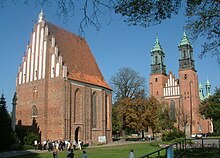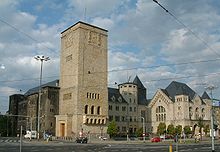Route of Kings and Emperors (Poznan)

The Route of Kings and Emperors is the name of a tourist route in Poznan in Poland.
The Route of Kings and Emperors includes the main attractions of the city of Poznan. It leads to places that are connected to the rulers and thus passes through the historically most valuable districts that document the urban and cultural development of the city. Various projects are grouped under the name "The Route of Kings and Emperors". a. Events of a cultural, artistic and educational nature, which are realized in close cooperation with the public administration, institutions from education and science as well as representatives of the arts and universities and tourism organizations. The route of the kings and emperors represents a common basis for action and enables close cooperation in the development of a uniform cultural and tourist offer for the city. The program, which began in 2005, is under the auspices of the City Office (City Development Office of the Poznan City Council). It represents the implementation of some of the guidelines of the National Strategy for Cultural Development (2004–2013).
Historical context
The name "The Route of Kings and Emperors" refers to the history of the city. The route is called "royal" because various kings were buried in the Poznan Cathedral :
- Mieszko I. (the name of his wife Dobrawa is also connected to the route)
- Boleslaw I.
- Mieszko II. Lambert
- Casimir I.
- Wladyslaw Odon
- Przemyslaw I.
- Bolesław of Greater Poland
- Przemysław II.
Around 1290, Przemysław II, a great advocate of the reunification of Polish duchies after the period of particularism , began building the Royal Palace, where many important events for the Kingdom of Poland took place. The coat of arms of the Polish state was created here. From the time of Władysław I. Ellenlang the castle was the residence of the general starosts of Greater Poland . Guests at the royal palace were:
- Casimir the Great
- Ludwig I.
- Hedwig / Jadwiga
- Władysław II Jagiełło
- Johann I. Albrecht
- Casimir II of the Jagiellonian
- Sigismund I the Old
- Henry of Valois
- Sigismund III.
- John II Casimir
The term "imperial" refers to the visits:
- of the Roman-German Emperor Otto III. who was in Poznan in 1000 on his pilgrimage to Gniezno ;
- of the French Emperor Napoleon I , who stayed in Poznan in 1806 and 1807 and twice in 1812. During his first visit he resided in the Jesuit college . From here he led his troops, which made Posen, as one chronicler called it, the center of the European world;
- of the last German Emperor and King of Prussia Wilhelm II , who had the imperial palace built in Posen .
The course of the route
The course of the route illustrates the architectural and urban development of the city: starting with the places where the Polish state began, through the city of the Middle Ages and modern times to the present . The route of kings and emperors is as follows:
Lake Malta - Church of St. John of Jerusalem Extra Muros - Srodka - Jordan Bridge - Ostrów Tumski - Bolesław Chrobry Bridge - Chwaliszewo - Old Market Square - Paderewski Street - Plac Wolnosci - 27. Grudnia Street - Fredry Street - Most Tatralny - JH Dabrowskiego Street - Herz- Jesus and St. Florian Church.
Sights and monuments along the route
- St. Johann-zu-Jerusalem-Kirche Extra Muros
- Lake Malta with its sports and leisure facilities
- Station of the "Maltanka" small train
- St. Casimir Church
- St. Margaretha Church
- Oratorian monastery
- Jordan Bridge
- The Archbishop St. Peter and Paul Cathedral
- Archbishop's Palace
- Church of the Most Holy Virgin Mary
- Psałteria - the house of choirs
- Archdiocese Museum in the Lubrański Academy
- Herz-Jesu-Kirche, also consecrated to the comforting mother of God
- New synagogue
- Memorial to the writer Józef I. Kraszewski
- Church of the Most Holy Virgin Mary of the Aid of Christians
- Theater "Scena na Piętrze"
- city wall
- St. Adalbert's Church with the crypt of the deserving deceased of the Wielkopolska
- Citadel, Armaments Museum and Army Museum "Poznań" (in the former Winiary Fort)
- Church of the Most Holy Blood of Christ
- town hall
- City scales
- "Bamberka" fountain
- General stores
- Wielkopolska Military Museum (Department of the Poznan National Museum)
- City Gallery "Arsenał"
- Hauptwache - Museum of the Poznan Uprising 1918-1919
- Castle of the Działynski family
- Henryk Sienkiewicz Literature Museum
- Castle of the Mielżynski family
- Museum of Musical Instruments
- Museum of Applied Arts (former royal palace )
- St. Anthony of Padua Church and Monastery of the Franciscan Minorites (the city model of old Poznan in the basement)
- Castle of the Górka family (Archaeological Museum)
- Ballet school and seat of the Polish Dance Theater - Poznan Ballet (former Jesuit school)
- Collegiate and parish church in honor of St. Bishop Stanislaus and former Jesuit college (currently Poznan City Office)
- All Saints Church
- Ethnographic Museum (former Masonic Lodge )
- Museum of the Poznan Bamberg
- Statue of a lamp lighter
- St. Francis of Assis Church
- Corpus Christi Church
- Shopping, art and business center - " Old Brewery "
- Musical theater
- Monument to the Old Marych
- St. Martin's Church
- "Bazaar"
- National Museum - painting and plastic gallery
- Raczyński Library
- "Arkadia" - seat of the Eighth Day Theater and the City Information Center
- University library
- Polish theater
- "Okrąglak"
- Poznan Society of Friends of Science
- Heilandskirche
- Collegium Maius (former building of the Prussian settlement commission )
- Stanisław Moniuszko Theater (Opera House)
- Cultural center "Zamek" (former imperial palace )
- Monument to Poznan June 1956 and Adam Mickiewicz statue
- Adam Mickiewicz University - Collegium Minus and the university auditorium (concert hall of the Tadeusz Szeligowski Philharmonic in Poznan)
- Concert hall "Aula Nova"
- Palm house ("Palmiarnia") in Wilson Park
- Old zoo
- Memorial of the poet Kazimiera Iłłakiwiczówna
- "New Theater" - playhouse
- Art Nouveau houses on Roosevelta Street
- Art Nouveau buildings and half-timbered facades on Dąbrowskiego Street
- Sacred Heart and St. Florian Church.
literature
- Dorota Matyaszczyk: Poznań. The route of kings and emperors. Poznan 2008
- Daina Kolbuszewska, The Program Office “Royal-Imperial Route Posen”: Royal-Imperial Route in Poznan. Poznan 2007.
Web links
- The route of kings and emperors in Poznan (English)
- The route of the kings and emperors in Poznan on wikitravel.org
- Tourist routes on poznan.pl





